Middle Roman Imperial Period Glassware
The Catalogue
Middle Roman Imperial Period Glassware
Bowl with Base
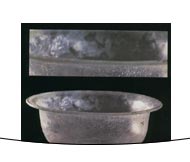 Height:
4.6 cm, Diameter of Rim: 10 cm, Diameter of Base: 4.9 cm.
Height:
4.6 cm, Diameter of Rim: 10 cm, Diameter of Base: 4.9 cm.
Found around Elmalı, Antalya.
Light blue-green, transparent glass, made by free-blowing. Has a round rim, an
S-shaped body, a hollow base-ring, and a slightly concave bottom. The body is
asymmetrical. There are some air bubbles in the glass. There is weathering on
the exterior surface.
Date: The Early Roman Imperial Period, 1st -2nd century AD.
Similar Examples: C.Isings, 1957, p.58, form 42; C.Lightfoot, 1989, p.82,
fig.2/1; M.Vanderhoeven, 1961, p.43, nr.43; G.Platz Horster, 1976, fig.152; Beat
Rutti, 1991, p.106, pl-92, fig.2016 form AR 109.2.
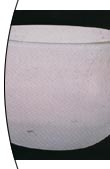 Kaunos
Bowl
Kaunos
Bowl
Height: 6.5 cm, Diameter of Rim: 8.2 cm.
Found in the excavations in Kaunos in 1974. Excavation inventory number: 69/63.
Light blue transparent glass, made by free-blowing. Has a round rim, polished by
fire. Body tapers inward at the belly and expands out to the flattened bottom.
This is a drinking cup; height and diameter are almost equal. There are some air
bubbles in the glass and weathering on the exterior surface.
Date: The Middle Roman Imperial Period, 2nd -3rd century AD.
Similar Examples: G.Platz Horster, 1976, p.82, fig.165; C.Isings, 1957, p.113,
form 96; C.Lightfoot, 1992, p.71, fig.27.
Flat Bottom Bowl
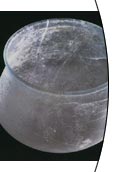 Height:
7.2 cm, Diameter of Rim: 7.9 cm, Diameter of Body: 9.7 cm.
Height:
7.2 cm, Diameter of Rim: 7.9 cm, Diameter of Body: 9.7 cm.
Found around Elmalı, Antalya.
Light blue, transparent glass, made by free-blowing. Has a flared, round, thick
rim, a body that expands downward to the flattened bottom. There is some
weathering and dullness and a few cracks on the exterior surface.
Date: The Middle Roman Imperial Period, 2nd -3rd century AD.
Similar Examples: Beat Rutti, 1991, p.101, fig.1980 form AR 103.
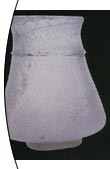 Vase
Vase
Height: 8.5 cm, Diameter of Rim: 4.5 cm.
Found in Marmaris.
Almost colourless light-yellow, transparent glass, made by free-blowing. Has an
unshaped rim, a short concave neck, a conical body which expands downward to the
bottom, a slightly concave bottom and a base-ring. There is a thick ornamental
ribbon encircling the neck of the vase. There is weathering on the exterior
surface. This may be a local product.
Date: The Middle Roman Imperial Period, 2nd -3rd century AD.
Similar Examples: O.Vessberg, 1952, Pl.IV 34; C.Lightfoot, 1989, p.87, nr.38,
fig.4/2; Y.Akat – N.Fıratlı, 1984, p.37, nr.296, fig.140.
Globular-Bodied Jug
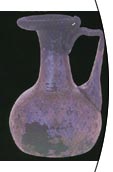 Height:
8 cm, Diameter of body: 5.5 cm.
Height:
8 cm, Diameter of body: 5.5 cm.
Origin unknown.
Blue transparent glass, made by free-blowing. Has a broad, round flared tubular
rim which is folded both in and out, a cylindrical neck, a squat globular body
and a slightly concave flattened bottom. The handle, which was added later by
drawing up molten glass from the shoulder, is ribbed and has a forked end. There
is weathering on the exterior surface.
Date: The Middle Roman Imperial Period, 2nd -3rd century AD.
Similar Examples: C.Lightfoot, 1989, p.84, fig.27 2/5; Y.Akat – N.Fıratlı, 1984,
p.36, fig.130; C.Ayabakan, 1990, p.49, photo 7.
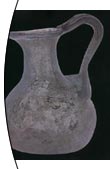 One-Handled
Jug
One-Handled
Jug
Height: 8 cm, Diameter of Body: 5.5 cm.
Origin unknown.
Light blue-green, transparent glass, made by free-blowing. Has an irregular
round rim which has been folded both in and out, a neck which expands through to
the body, a globular body and a deep bottom. The handle was added later. It has
a gentle rounded curve and a forked end and is attached directly to the mouth of
the jug. Some grooves have been made on the handle with a tool. There is
weathering on the exterior surface.
Date: The Middle Roman Imperial Period, 2nd century AD.
Similar Examples: C.Lightfoot, 1992, p.92, fig.48.
One-Handled Jug
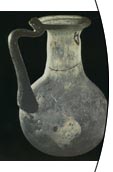 Height:
7.5 cm, Diameter of Belly: 5.2 cm.
Height:
7.5 cm, Diameter of Belly: 5.2 cm.
Found in Yatağan.
Light blue-green, transparent glass, made by free-blowing. Has an irregular,
round rim which has been folded both in and out, a neck which widens as it
descends, a globular body and a pressed bottom. The single handle begins on the
upper section of the body and, after making an elbow curve, is attached to the
rim. The upper end of the handle is drawn up and pressed into a shape that
serves as a finger rest. There are some air bubbles in the glass and weathering
on the exterior surface.
Date: The Middle Roman Imperial Period, 2nd century AD.
Similar Examples: C.Lightfoot, 1992, p.93, fig.49.
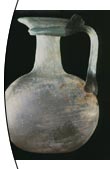 Jug
Jug
Height: 11 cm, Diameter of Body: 8 cm.
Origin unknown.
Light blue-green, transparent glass, made by free-blowing. Has a funnel-shaped
oval rim which is folded both in and out and a separate, second rim just below
it. Has a straight cylindrical neck, a globular body and a concave bottom. The
single handle was made by trailing up molten glass from the shoulder. Both ends
of handle are forked and its curved edges are folded inward. The handle is
attached to both the second ornamental rim and to the main rim. There is
weathering on the exterior surface.
Date: The Middle Roman Imperial Period, 2nd century AD.
Similar Examples: O.Vessberg, 1952, p.125, Pl.V/5; C.Lightfoot, 1992, p.56,
fig.20.
Jug
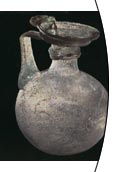 Height:
11 cm, Diameter of Bottom: 8.5 cm.
Height:
11 cm, Diameter of Bottom: 8.5 cm.
Origin unknown.
Light blue-green, transparent glass, made by free-blowing. Has a spouted,
oval-shaped rim which is folded both in and out, with one glass ring on the rim
and another heavier one just below it. It has a short, straight cylindrical
neck, a globular body and a concave bottom. The handle was made by trailing
molten glass from the shoulder and after the curve, attaching it to both the
ornamental second ring and to the rim of the jug. The handle was folded in two
and then pressed together. The embellishment on the neck of the jug was made by
welding two separate rings of glass together. There is weathering on the
exterior surface.
Date: The Middle Roman Imperial Period, 2nd century AD.
Similar Examples: Beat Rutti, 1991, p.173, fig.4110 form AR 172.1.
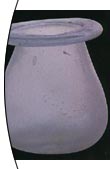 Miniature
Bottle
Miniature
Bottle
Height: 3.9 cm, Diameter of Rim: 3.7 cm, Diameter of Belly: 3.6 cm.
Origin unknown.
Light blue, transparent glass, made by free-blowing. Has a tubular-shaped rim
that has been folded in and out and then flattened into a horizontal surface, a
conical body and a flattened bottom. It is known in the literature as a
miniature jar.
Date: The Middle Roman Imperial Period, 2nd -3rd century AD.
Similar Examples: M.Stern, 1989, p.602, photo 11; M.Vanderhoeven, 1961, p.95,
fig.105; C.Isings, 1957, p.88, form 68; C.Lightfoot, 1992, p.213, fig.141-142;
Beat Rutti, 1991, p.107, form AR 113, Pl.93.